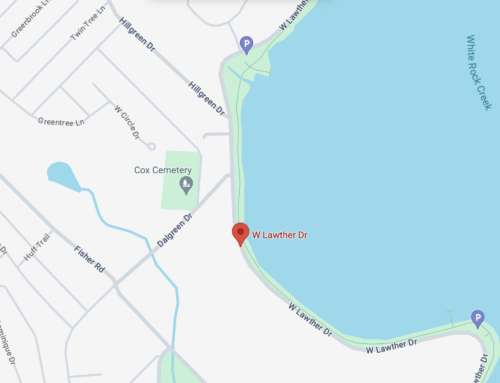Laura and Andrew Bruder were ecstatic to move into their new house on Goforth Road in mid-September. The street, tucked along White Rock Creek, doesn’t feel like it’s in the middle of a city. Wild turkeys and peacocks roam the street. Horses graze at nearby White Rock Stables’ property.
“I just love that it’s green,” Laura Bruder says. “We really landed upon this house really quickly.”
But the Bruders have yet to move there. The house was deemed uninhabitable nearly three months after they packed up their East Dallas condo.
“For now, it’s just a little bizarre life has taken this turn,” she says.
The Bruders closed on their ranch house on a Friday. They didn’t know more than 8 inches of rain would fall in 24 hours. Or that news stations would report White Rock Creek cresting at a record-setting 91.5 feet near Greenville Avenue.
Instead Andrew woke up early that Saturday, eager to meet the house painters. The steady downpour made him a little apprehensive.
Goforth Road is located in the 100-year floodplain, but longtime neighbors had reassured the Bruders they’d never experienced damage to their homes.
The term “100-year floodplain” itself is misleading; it doesn’t mean that flooding occurs once every century. The hundred-year floodplain is an area subject to 1-percent chance of significant flooding in any given year.
In the 1960s, the basis for the National Flood Insurance Program (NFIP) became the one-percent annual exceedance probability (AEP) flood, according to the United States Geological Survey. Statistical probability is used to assess flood risk.
In other words, when and how often a flood occurs is really up to chance.
Andrew never made it to their new house. Standing water on Lawther Drive rushed into his car. He was OK, he told Laura on the phone, but the car was completely flooded.
“We discovered a few hours later that the car is the least of our worries,” Laura says. “The house was totally flooded.”
If Andrew somehow reached Goforth, he would have seen that all but one of the houses was vacated. Railroad ties floated in waist-high water. Mailboxes were completely submerged, although one detached and drifted away.
Goforth Road residents acknowledge that living in a floodplain is risky. When it rains, they park their cars on nearby streets knowing the road floods quickly.
But they say September’s flood was unprecedented, and rain has submerged the street several times since then. They worry that once they’ve completed reconstruction, the same thing will happen again.
Michelle and Brandon Zuniga initially thought their home wasn’t damaged from water and focused their efforts on assisting their neighbors. A week later, tiles popped off the walls. They discovered floodwater had seeped from their crawl space vents into their walls and floors.
The day of the flood, the Zunigas watched as water slowly climbed up the five front steps to their one-story house. It was 3:30 a.m. when Michelle decided to go back to bed. Brandon wanted to pack a suitcase and pick up any belongings off the floor. She thought it was silly.
Then they saw water seep into their bathroom. The water in their backyard was higher than their shoes. The Zunigas woke up their 7-month-old son. Thirty minutes later, the water was knee-high, and it was so dark they couldn’t distinguish the floodwater from the pool.
Michelle’s boots weren’t high enough to safely wade through the yard. So her husband carried their baby and then Michelle to the car.
Like the Zunigas, Sarah Hargesheimer didn’t realize the severity of the flooding until she and her husband, Caleb, ushered their 2-year-old daughter out in the middle of the night. The water destroyed the cabinets and crib he built. They renovated the house they bought in 2010 together and finished remodeling in 2015.
“Your biggest investment is literally underwater,” Sarah says. “We’ve poured everything into that. Every penny feels sacred.”
Neighbors on Goforth have insurance through the Federal Emergency Management Agency’s National Flood Insurance Program. Dallas participates in the Community Rating Systems program, which is an incentive program designed to increase flood awareness. Dallas has a high rating, so residents have a 25 percent discount on their flood insurance premiums.
The insurance, though, doesn’t cover temporary housing, neighbors say. The property itself and the belongings inside are two separate deductibles. Any unattached structures, such as garages and sheds, also are not covered under the policy.
Most residents are staying with family members. Others, like the Hargesheimers, are house hopping.
“As an adult, that’s hard,” Sarah says. “As an adult with a 2-year-old, it’s a whole new level of difficult.”
The day after the flood, Natalie and Matt Wilson, who live a few blocks away, surveyed the area to see what neighbors needed. They’ve collected donations and managed a GoFundMe page to help with preliminary costs, too.
“That’s the best part, realizing our community is a community,” Sarah says. “We’ve been blessed to be at the forefront of everyone’s mind.”
Once neighbors receive insurance money to rebuild, the process will take about three to four months. Despite the hassle, this hasn’t deterred neighbors from living on Goforth. Some point out that even if they did plan to sell, no one would be willing to buy.
“We love our neighbors, this area, so we hope it just doesn’t happen again,” Zuniga says.
To find out if you live in a floodplain, visit https://msc.fema.gov/portal/home.







